Research Proposal: Exploring Packaging's Role in Louis Vuitton's Brand
VerifiedAdded on 2023/06/12
|11
|3728
|448
AI Summary
This research proposal aims to explore the role of packaging in shaping and changing brand perceptions of luxury brands, specifically focusing on Louis Vuitton. It delves into the concept of branding, particularly for luxury goods, and identifies the key aspects of packaging that contribute to a competitive edge. The study seeks to evaluate the impact of packaging on consumer perceptions, addressing questions about the meaning of branding for luxury goods, the different aspects of packaging, and its overall role in shaping brand perceptions. The proposal includes a literature review covering brand concepts, brand identity, and the relationship between packaging and brand image, and formulates hypotheses to test the significance of packaging on consumer perceptions.
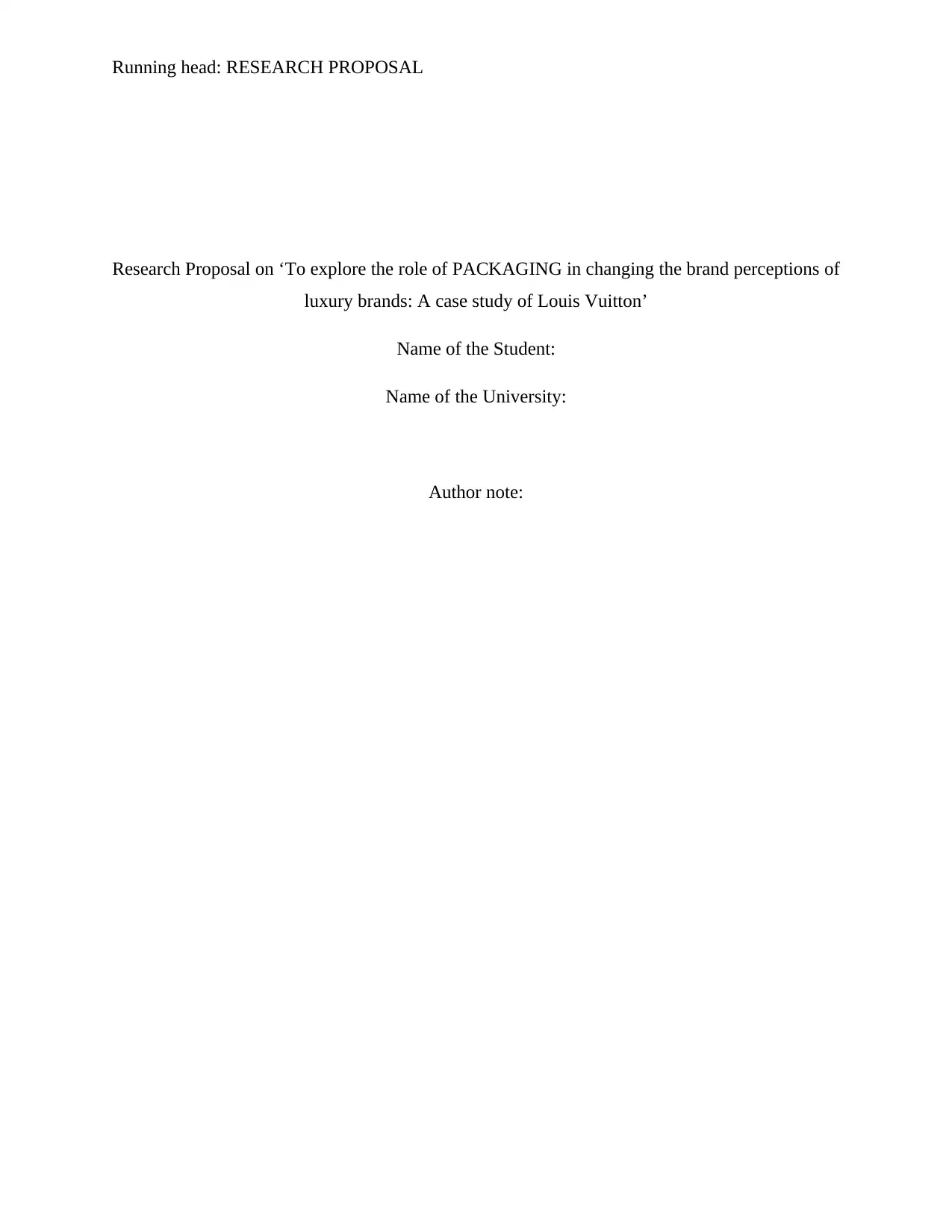
Running head: RESEARCH PROPOSAL
Research Proposal on ‘To explore the role of PACKAGING in changing the brand perceptions of
luxury brands: A case study of Louis Vuitton’
Name of the Student:
Name of the University:
Author note:
Research Proposal on ‘To explore the role of PACKAGING in changing the brand perceptions of
luxury brands: A case study of Louis Vuitton’
Name of the Student:
Name of the University:
Author note:
Paraphrase This Document
Need a fresh take? Get an instant paraphrase of this document with our AI Paraphraser
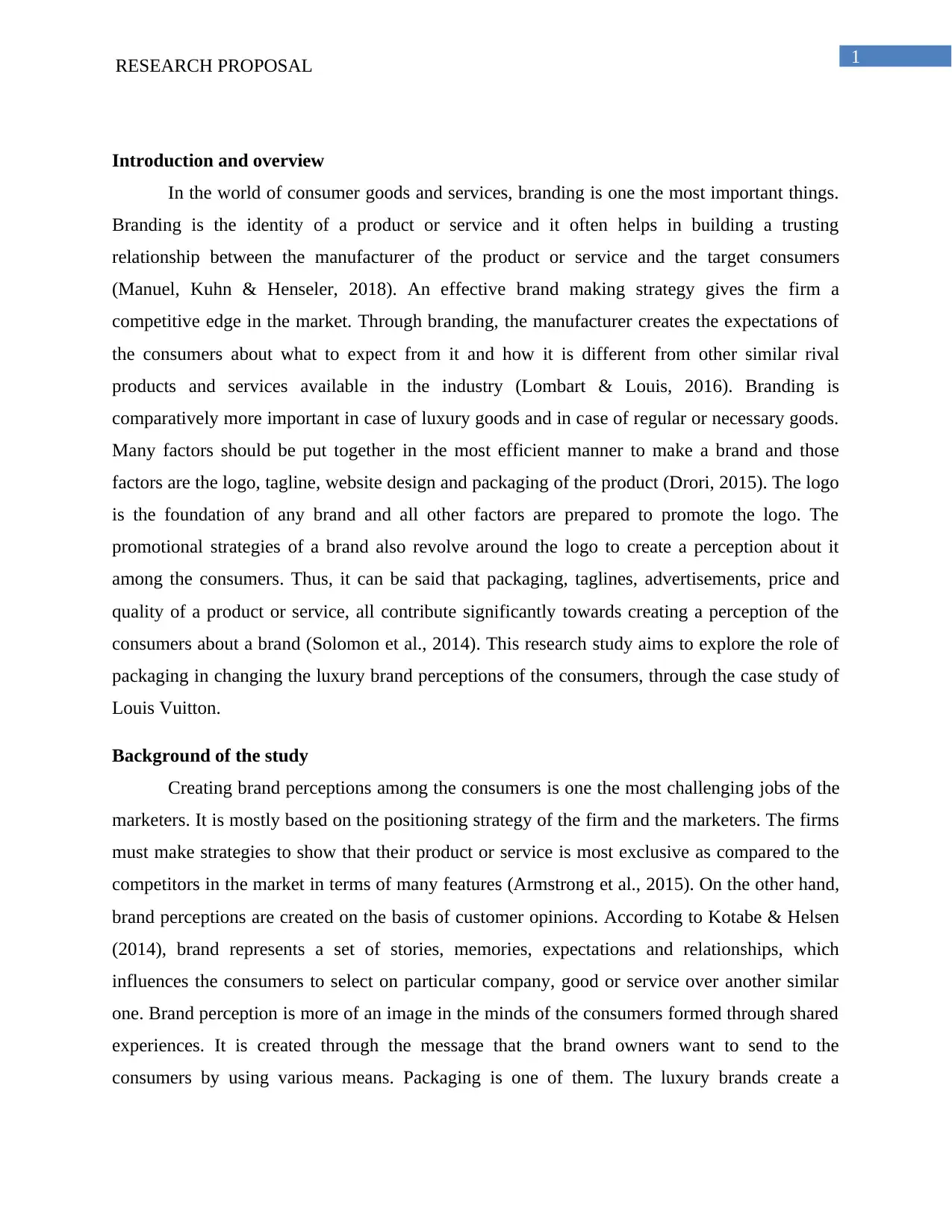
1RESEARCH PROPOSAL
Introduction and overview
In the world of consumer goods and services, branding is one the most important things.
Branding is the identity of a product or service and it often helps in building a trusting
relationship between the manufacturer of the product or service and the target consumers
(Manuel, Kuhn & Henseler, 2018). An effective brand making strategy gives the firm a
competitive edge in the market. Through branding, the manufacturer creates the expectations of
the consumers about what to expect from it and how it is different from other similar rival
products and services available in the industry (Lombart & Louis, 2016). Branding is
comparatively more important in case of luxury goods and in case of regular or necessary goods.
Many factors should be put together in the most efficient manner to make a brand and those
factors are the logo, tagline, website design and packaging of the product (Drori, 2015). The logo
is the foundation of any brand and all other factors are prepared to promote the logo. The
promotional strategies of a brand also revolve around the logo to create a perception about it
among the consumers. Thus, it can be said that packaging, taglines, advertisements, price and
quality of a product or service, all contribute significantly towards creating a perception of the
consumers about a brand (Solomon et al., 2014). This research study aims to explore the role of
packaging in changing the luxury brand perceptions of the consumers, through the case study of
Louis Vuitton.
Background of the study
Creating brand perceptions among the consumers is one the most challenging jobs of the
marketers. It is mostly based on the positioning strategy of the firm and the marketers. The firms
must make strategies to show that their product or service is most exclusive as compared to the
competitors in the market in terms of many features (Armstrong et al., 2015). On the other hand,
brand perceptions are created on the basis of customer opinions. According to Kotabe & Helsen
(2014), brand represents a set of stories, memories, expectations and relationships, which
influences the consumers to select on particular company, good or service over another similar
one. Brand perception is more of an image in the minds of the consumers formed through shared
experiences. It is created through the message that the brand owners want to send to the
consumers by using various means. Packaging is one of them. The luxury brands create a
Introduction and overview
In the world of consumer goods and services, branding is one the most important things.
Branding is the identity of a product or service and it often helps in building a trusting
relationship between the manufacturer of the product or service and the target consumers
(Manuel, Kuhn & Henseler, 2018). An effective brand making strategy gives the firm a
competitive edge in the market. Through branding, the manufacturer creates the expectations of
the consumers about what to expect from it and how it is different from other similar rival
products and services available in the industry (Lombart & Louis, 2016). Branding is
comparatively more important in case of luxury goods and in case of regular or necessary goods.
Many factors should be put together in the most efficient manner to make a brand and those
factors are the logo, tagline, website design and packaging of the product (Drori, 2015). The logo
is the foundation of any brand and all other factors are prepared to promote the logo. The
promotional strategies of a brand also revolve around the logo to create a perception about it
among the consumers. Thus, it can be said that packaging, taglines, advertisements, price and
quality of a product or service, all contribute significantly towards creating a perception of the
consumers about a brand (Solomon et al., 2014). This research study aims to explore the role of
packaging in changing the luxury brand perceptions of the consumers, through the case study of
Louis Vuitton.
Background of the study
Creating brand perceptions among the consumers is one the most challenging jobs of the
marketers. It is mostly based on the positioning strategy of the firm and the marketers. The firms
must make strategies to show that their product or service is most exclusive as compared to the
competitors in the market in terms of many features (Armstrong et al., 2015). On the other hand,
brand perceptions are created on the basis of customer opinions. According to Kotabe & Helsen
(2014), brand represents a set of stories, memories, expectations and relationships, which
influences the consumers to select on particular company, good or service over another similar
one. Brand perception is more of an image in the minds of the consumers formed through shared
experiences. It is created through the message that the brand owners want to send to the
consumers by using various means. Packaging is one of them. The luxury brands create a
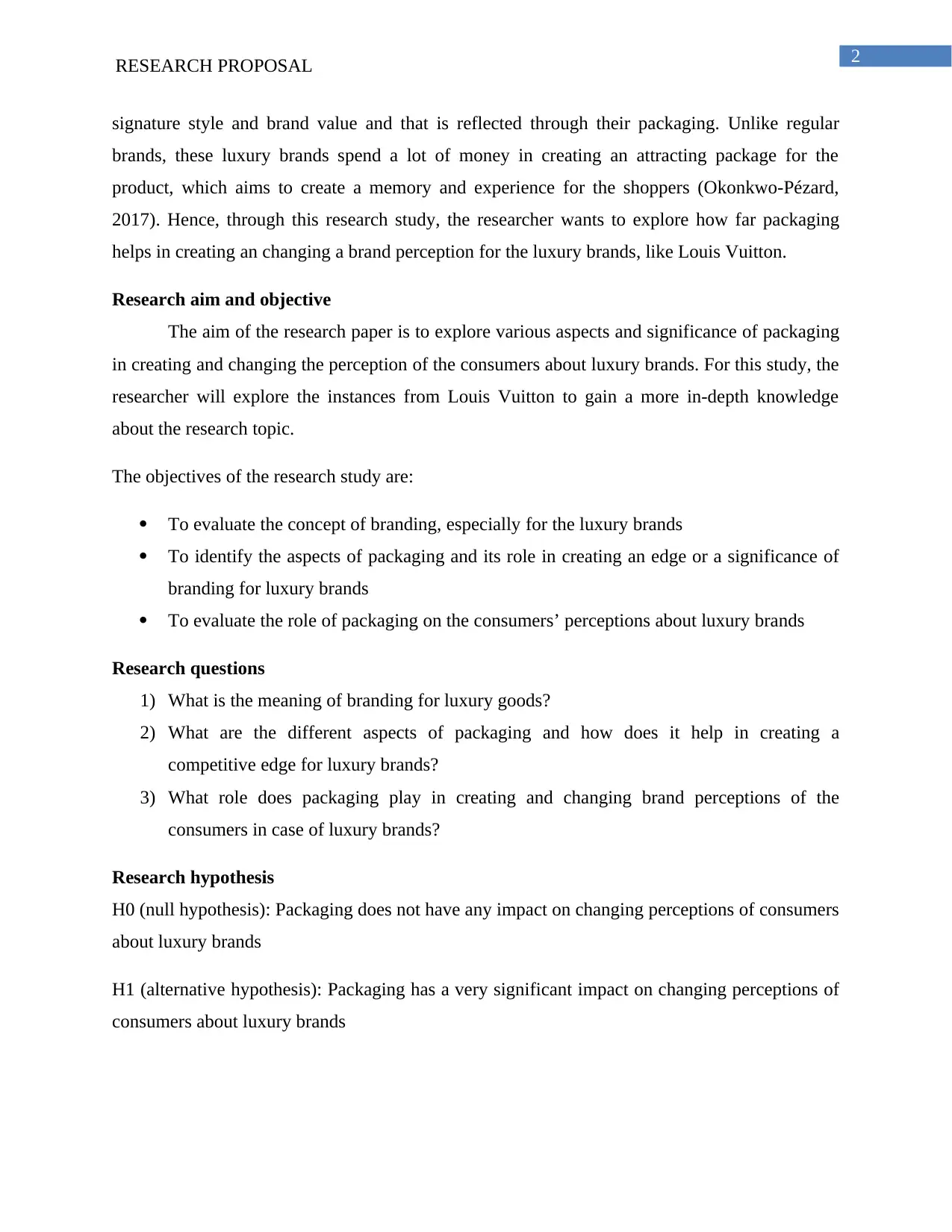
2RESEARCH PROPOSAL
signature style and brand value and that is reflected through their packaging. Unlike regular
brands, these luxury brands spend a lot of money in creating an attracting package for the
product, which aims to create a memory and experience for the shoppers (Okonkwo-Pézard,
2017). Hence, through this research study, the researcher wants to explore how far packaging
helps in creating an changing a brand perception for the luxury brands, like Louis Vuitton.
Research aim and objective
The aim of the research paper is to explore various aspects and significance of packaging
in creating and changing the perception of the consumers about luxury brands. For this study, the
researcher will explore the instances from Louis Vuitton to gain a more in-depth knowledge
about the research topic.
The objectives of the research study are:
To evaluate the concept of branding, especially for the luxury brands
To identify the aspects of packaging and its role in creating an edge or a significance of
branding for luxury brands
To evaluate the role of packaging on the consumers’ perceptions about luxury brands
Research questions
1) What is the meaning of branding for luxury goods?
2) What are the different aspects of packaging and how does it help in creating a
competitive edge for luxury brands?
3) What role does packaging play in creating and changing brand perceptions of the
consumers in case of luxury brands?
Research hypothesis
H0 (null hypothesis): Packaging does not have any impact on changing perceptions of consumers
about luxury brands
H1 (alternative hypothesis): Packaging has a very significant impact on changing perceptions of
consumers about luxury brands
signature style and brand value and that is reflected through their packaging. Unlike regular
brands, these luxury brands spend a lot of money in creating an attracting package for the
product, which aims to create a memory and experience for the shoppers (Okonkwo-Pézard,
2017). Hence, through this research study, the researcher wants to explore how far packaging
helps in creating an changing a brand perception for the luxury brands, like Louis Vuitton.
Research aim and objective
The aim of the research paper is to explore various aspects and significance of packaging
in creating and changing the perception of the consumers about luxury brands. For this study, the
researcher will explore the instances from Louis Vuitton to gain a more in-depth knowledge
about the research topic.
The objectives of the research study are:
To evaluate the concept of branding, especially for the luxury brands
To identify the aspects of packaging and its role in creating an edge or a significance of
branding for luxury brands
To evaluate the role of packaging on the consumers’ perceptions about luxury brands
Research questions
1) What is the meaning of branding for luxury goods?
2) What are the different aspects of packaging and how does it help in creating a
competitive edge for luxury brands?
3) What role does packaging play in creating and changing brand perceptions of the
consumers in case of luxury brands?
Research hypothesis
H0 (null hypothesis): Packaging does not have any impact on changing perceptions of consumers
about luxury brands
H1 (alternative hypothesis): Packaging has a very significant impact on changing perceptions of
consumers about luxury brands
⊘ This is a preview!⊘
Do you want full access?
Subscribe today to unlock all pages.

Trusted by 1+ million students worldwide
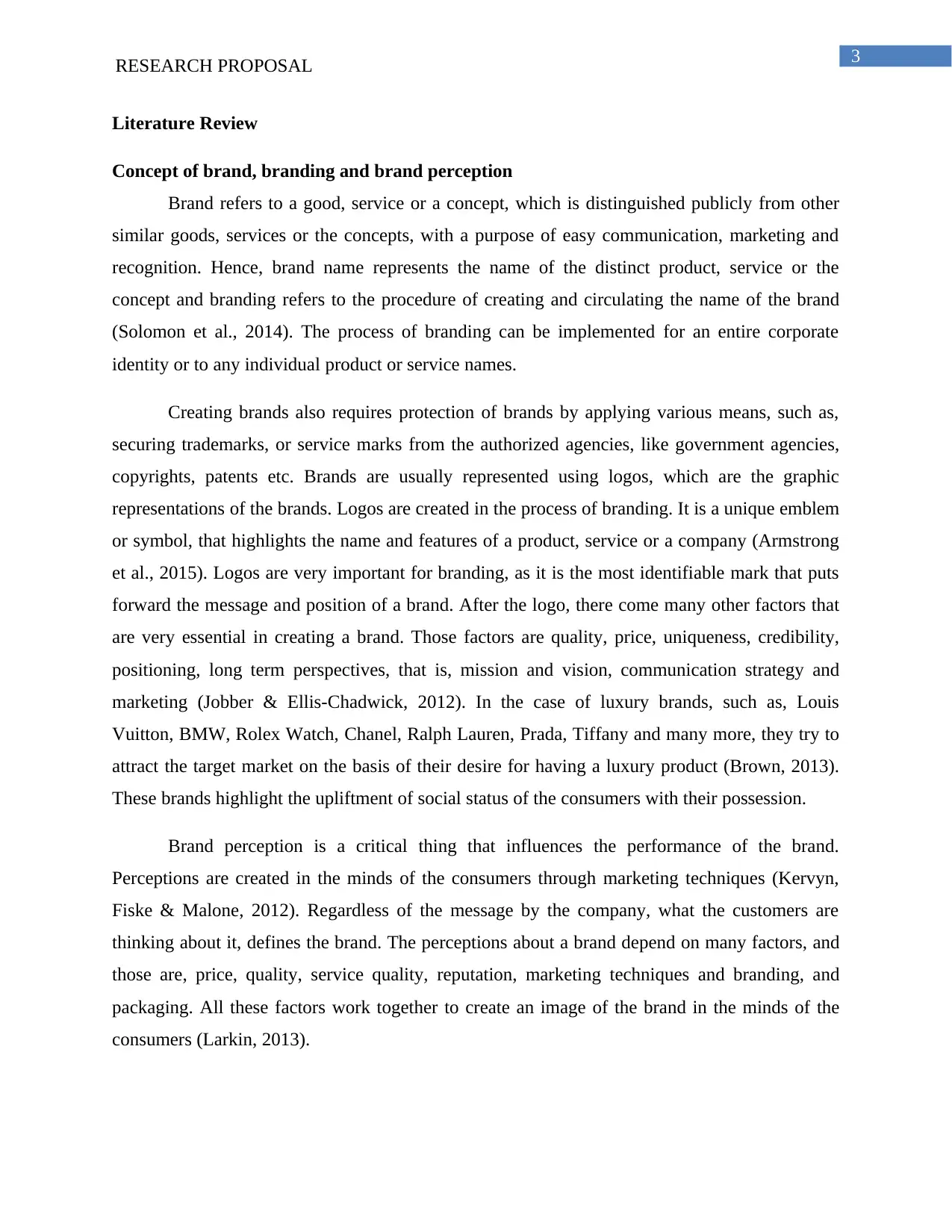
3RESEARCH PROPOSAL
Literature Review
Concept of brand, branding and brand perception
Brand refers to a good, service or a concept, which is distinguished publicly from other
similar goods, services or the concepts, with a purpose of easy communication, marketing and
recognition. Hence, brand name represents the name of the distinct product, service or the
concept and branding refers to the procedure of creating and circulating the name of the brand
(Solomon et al., 2014). The process of branding can be implemented for an entire corporate
identity or to any individual product or service names.
Creating brands also requires protection of brands by applying various means, such as,
securing trademarks, or service marks from the authorized agencies, like government agencies,
copyrights, patents etc. Brands are usually represented using logos, which are the graphic
representations of the brands. Logos are created in the process of branding. It is a unique emblem
or symbol, that highlights the name and features of a product, service or a company (Armstrong
et al., 2015). Logos are very important for branding, as it is the most identifiable mark that puts
forward the message and position of a brand. After the logo, there come many other factors that
are very essential in creating a brand. Those factors are quality, price, uniqueness, credibility,
positioning, long term perspectives, that is, mission and vision, communication strategy and
marketing (Jobber & Ellis-Chadwick, 2012). In the case of luxury brands, such as, Louis
Vuitton, BMW, Rolex Watch, Chanel, Ralph Lauren, Prada, Tiffany and many more, they try to
attract the target market on the basis of their desire for having a luxury product (Brown, 2013).
These brands highlight the upliftment of social status of the consumers with their possession.
Brand perception is a critical thing that influences the performance of the brand.
Perceptions are created in the minds of the consumers through marketing techniques (Kervyn,
Fiske & Malone, 2012). Regardless of the message by the company, what the customers are
thinking about it, defines the brand. The perceptions about a brand depend on many factors, and
those are, price, quality, service quality, reputation, marketing techniques and branding, and
packaging. All these factors work together to create an image of the brand in the minds of the
consumers (Larkin, 2013).
Literature Review
Concept of brand, branding and brand perception
Brand refers to a good, service or a concept, which is distinguished publicly from other
similar goods, services or the concepts, with a purpose of easy communication, marketing and
recognition. Hence, brand name represents the name of the distinct product, service or the
concept and branding refers to the procedure of creating and circulating the name of the brand
(Solomon et al., 2014). The process of branding can be implemented for an entire corporate
identity or to any individual product or service names.
Creating brands also requires protection of brands by applying various means, such as,
securing trademarks, or service marks from the authorized agencies, like government agencies,
copyrights, patents etc. Brands are usually represented using logos, which are the graphic
representations of the brands. Logos are created in the process of branding. It is a unique emblem
or symbol, that highlights the name and features of a product, service or a company (Armstrong
et al., 2015). Logos are very important for branding, as it is the most identifiable mark that puts
forward the message and position of a brand. After the logo, there come many other factors that
are very essential in creating a brand. Those factors are quality, price, uniqueness, credibility,
positioning, long term perspectives, that is, mission and vision, communication strategy and
marketing (Jobber & Ellis-Chadwick, 2012). In the case of luxury brands, such as, Louis
Vuitton, BMW, Rolex Watch, Chanel, Ralph Lauren, Prada, Tiffany and many more, they try to
attract the target market on the basis of their desire for having a luxury product (Brown, 2013).
These brands highlight the upliftment of social status of the consumers with their possession.
Brand perception is a critical thing that influences the performance of the brand.
Perceptions are created in the minds of the consumers through marketing techniques (Kervyn,
Fiske & Malone, 2012). Regardless of the message by the company, what the customers are
thinking about it, defines the brand. The perceptions about a brand depend on many factors, and
those are, price, quality, service quality, reputation, marketing techniques and branding, and
packaging. All these factors work together to create an image of the brand in the minds of the
consumers (Larkin, 2013).
Paraphrase This Document
Need a fresh take? Get an instant paraphrase of this document with our AI Paraphraser
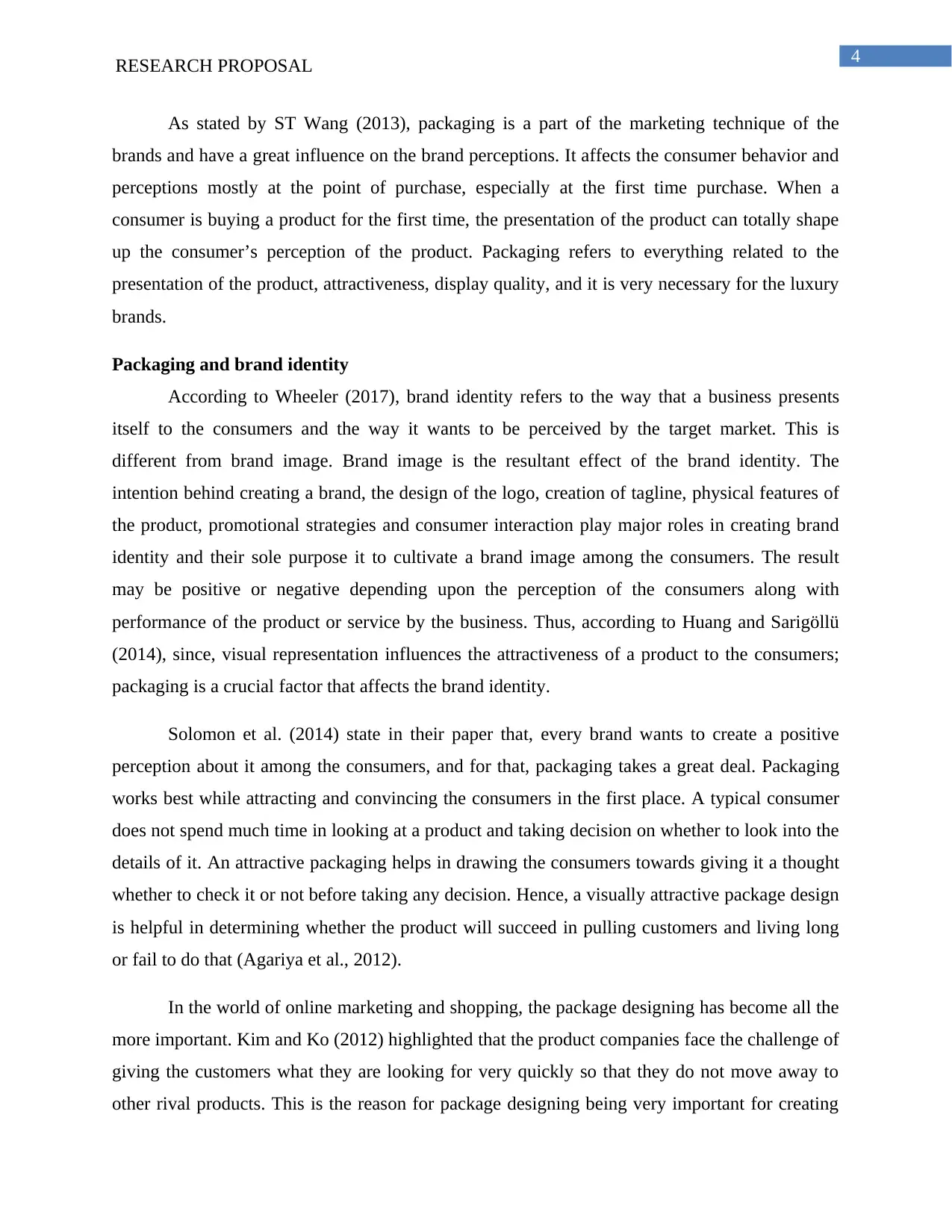
4RESEARCH PROPOSAL
As stated by ST Wang (2013), packaging is a part of the marketing technique of the
brands and have a great influence on the brand perceptions. It affects the consumer behavior and
perceptions mostly at the point of purchase, especially at the first time purchase. When a
consumer is buying a product for the first time, the presentation of the product can totally shape
up the consumer’s perception of the product. Packaging refers to everything related to the
presentation of the product, attractiveness, display quality, and it is very necessary for the luxury
brands.
Packaging and brand identity
According to Wheeler (2017), brand identity refers to the way that a business presents
itself to the consumers and the way it wants to be perceived by the target market. This is
different from brand image. Brand image is the resultant effect of the brand identity. The
intention behind creating a brand, the design of the logo, creation of tagline, physical features of
the product, promotional strategies and consumer interaction play major roles in creating brand
identity and their sole purpose it to cultivate a brand image among the consumers. The result
may be positive or negative depending upon the perception of the consumers along with
performance of the product or service by the business. Thus, according to Huang and Sarigöllü
(2014), since, visual representation influences the attractiveness of a product to the consumers;
packaging is a crucial factor that affects the brand identity.
Solomon et al. (2014) state in their paper that, every brand wants to create a positive
perception about it among the consumers, and for that, packaging takes a great deal. Packaging
works best while attracting and convincing the consumers in the first place. A typical consumer
does not spend much time in looking at a product and taking decision on whether to look into the
details of it. An attractive packaging helps in drawing the consumers towards giving it a thought
whether to check it or not before taking any decision. Hence, a visually attractive package design
is helpful in determining whether the product will succeed in pulling customers and living long
or fail to do that (Agariya et al., 2012).
In the world of online marketing and shopping, the package designing has become all the
more important. Kim and Ko (2012) highlighted that the product companies face the challenge of
giving the customers what they are looking for very quickly so that they do not move away to
other rival products. This is the reason for package designing being very important for creating
As stated by ST Wang (2013), packaging is a part of the marketing technique of the
brands and have a great influence on the brand perceptions. It affects the consumer behavior and
perceptions mostly at the point of purchase, especially at the first time purchase. When a
consumer is buying a product for the first time, the presentation of the product can totally shape
up the consumer’s perception of the product. Packaging refers to everything related to the
presentation of the product, attractiveness, display quality, and it is very necessary for the luxury
brands.
Packaging and brand identity
According to Wheeler (2017), brand identity refers to the way that a business presents
itself to the consumers and the way it wants to be perceived by the target market. This is
different from brand image. Brand image is the resultant effect of the brand identity. The
intention behind creating a brand, the design of the logo, creation of tagline, physical features of
the product, promotional strategies and consumer interaction play major roles in creating brand
identity and their sole purpose it to cultivate a brand image among the consumers. The result
may be positive or negative depending upon the perception of the consumers along with
performance of the product or service by the business. Thus, according to Huang and Sarigöllü
(2014), since, visual representation influences the attractiveness of a product to the consumers;
packaging is a crucial factor that affects the brand identity.
Solomon et al. (2014) state in their paper that, every brand wants to create a positive
perception about it among the consumers, and for that, packaging takes a great deal. Packaging
works best while attracting and convincing the consumers in the first place. A typical consumer
does not spend much time in looking at a product and taking decision on whether to look into the
details of it. An attractive packaging helps in drawing the consumers towards giving it a thought
whether to check it or not before taking any decision. Hence, a visually attractive package design
is helpful in determining whether the product will succeed in pulling customers and living long
or fail to do that (Agariya et al., 2012).
In the world of online marketing and shopping, the package designing has become all the
more important. Kim and Ko (2012) highlighted that the product companies face the challenge of
giving the customers what they are looking for very quickly so that they do not move away to
other rival products. This is the reason for package designing being very important for creating
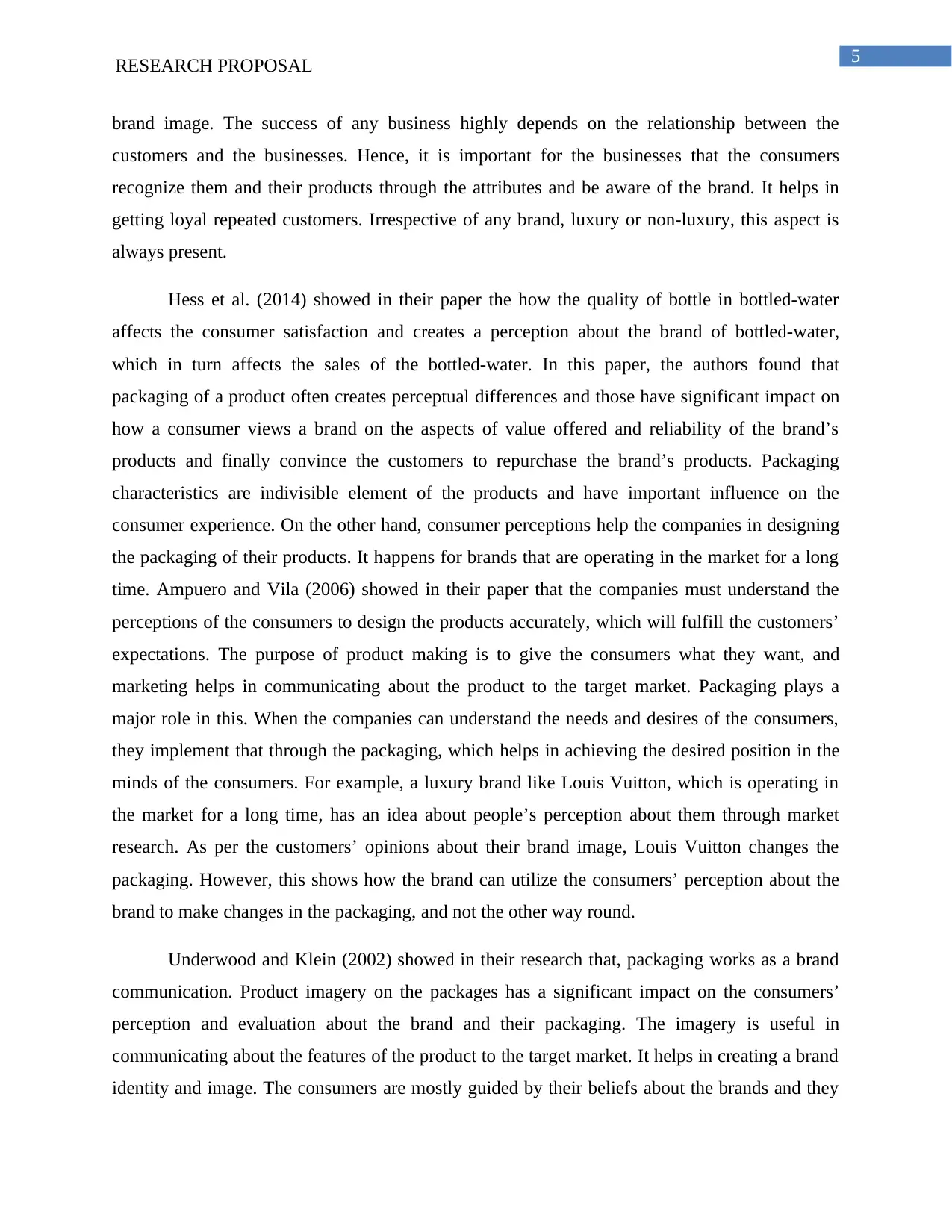
5RESEARCH PROPOSAL
brand image. The success of any business highly depends on the relationship between the
customers and the businesses. Hence, it is important for the businesses that the consumers
recognize them and their products through the attributes and be aware of the brand. It helps in
getting loyal repeated customers. Irrespective of any brand, luxury or non-luxury, this aspect is
always present.
Hess et al. (2014) showed in their paper the how the quality of bottle in bottled-water
affects the consumer satisfaction and creates a perception about the brand of bottled-water,
which in turn affects the sales of the bottled-water. In this paper, the authors found that
packaging of a product often creates perceptual differences and those have significant impact on
how a consumer views a brand on the aspects of value offered and reliability of the brand’s
products and finally convince the customers to repurchase the brand’s products. Packaging
characteristics are indivisible element of the products and have important influence on the
consumer experience. On the other hand, consumer perceptions help the companies in designing
the packaging of their products. It happens for brands that are operating in the market for a long
time. Ampuero and Vila (2006) showed in their paper that the companies must understand the
perceptions of the consumers to design the products accurately, which will fulfill the customers’
expectations. The purpose of product making is to give the consumers what they want, and
marketing helps in communicating about the product to the target market. Packaging plays a
major role in this. When the companies can understand the needs and desires of the consumers,
they implement that through the packaging, which helps in achieving the desired position in the
minds of the consumers. For example, a luxury brand like Louis Vuitton, which is operating in
the market for a long time, has an idea about people’s perception about them through market
research. As per the customers’ opinions about their brand image, Louis Vuitton changes the
packaging. However, this shows how the brand can utilize the consumers’ perception about the
brand to make changes in the packaging, and not the other way round.
Underwood and Klein (2002) showed in their research that, packaging works as a brand
communication. Product imagery on the packages has a significant impact on the consumers’
perception and evaluation about the brand and their packaging. The imagery is useful in
communicating about the features of the product to the target market. It helps in creating a brand
identity and image. The consumers are mostly guided by their beliefs about the brands and they
brand image. The success of any business highly depends on the relationship between the
customers and the businesses. Hence, it is important for the businesses that the consumers
recognize them and their products through the attributes and be aware of the brand. It helps in
getting loyal repeated customers. Irrespective of any brand, luxury or non-luxury, this aspect is
always present.
Hess et al. (2014) showed in their paper the how the quality of bottle in bottled-water
affects the consumer satisfaction and creates a perception about the brand of bottled-water,
which in turn affects the sales of the bottled-water. In this paper, the authors found that
packaging of a product often creates perceptual differences and those have significant impact on
how a consumer views a brand on the aspects of value offered and reliability of the brand’s
products and finally convince the customers to repurchase the brand’s products. Packaging
characteristics are indivisible element of the products and have important influence on the
consumer experience. On the other hand, consumer perceptions help the companies in designing
the packaging of their products. It happens for brands that are operating in the market for a long
time. Ampuero and Vila (2006) showed in their paper that the companies must understand the
perceptions of the consumers to design the products accurately, which will fulfill the customers’
expectations. The purpose of product making is to give the consumers what they want, and
marketing helps in communicating about the product to the target market. Packaging plays a
major role in this. When the companies can understand the needs and desires of the consumers,
they implement that through the packaging, which helps in achieving the desired position in the
minds of the consumers. For example, a luxury brand like Louis Vuitton, which is operating in
the market for a long time, has an idea about people’s perception about them through market
research. As per the customers’ opinions about their brand image, Louis Vuitton changes the
packaging. However, this shows how the brand can utilize the consumers’ perception about the
brand to make changes in the packaging, and not the other way round.
Underwood and Klein (2002) showed in their research that, packaging works as a brand
communication. Product imagery on the packages has a significant impact on the consumers’
perception and evaluation about the brand and their packaging. The imagery is useful in
communicating about the features of the product to the target market. It helps in creating a brand
identity and image. The consumers are mostly guided by their beliefs about the brands and they
⊘ This is a preview!⊘
Do you want full access?
Subscribe today to unlock all pages.

Trusted by 1+ million students worldwide
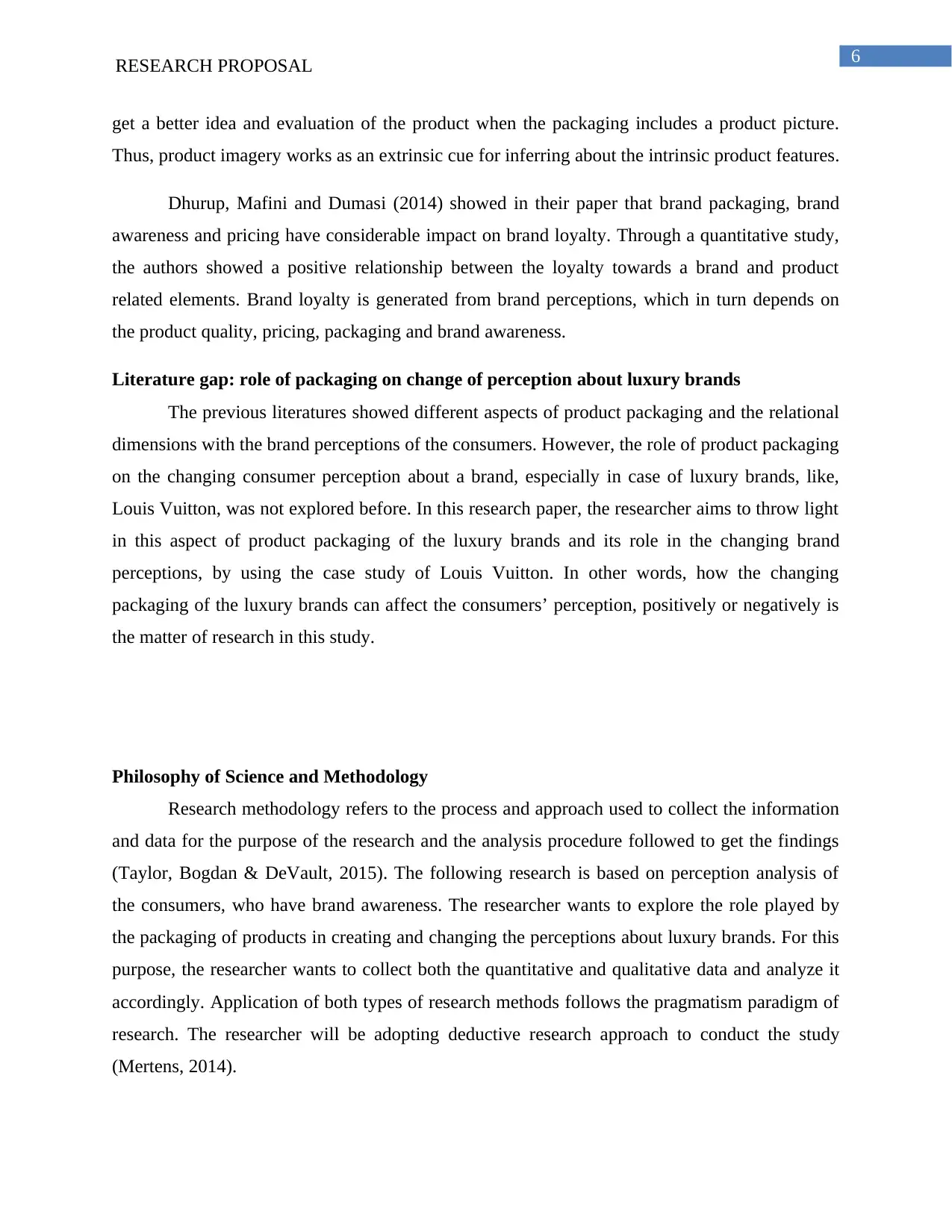
6RESEARCH PROPOSAL
get a better idea and evaluation of the product when the packaging includes a product picture.
Thus, product imagery works as an extrinsic cue for inferring about the intrinsic product features.
Dhurup, Mafini and Dumasi (2014) showed in their paper that brand packaging, brand
awareness and pricing have considerable impact on brand loyalty. Through a quantitative study,
the authors showed a positive relationship between the loyalty towards a brand and product
related elements. Brand loyalty is generated from brand perceptions, which in turn depends on
the product quality, pricing, packaging and brand awareness.
Literature gap: role of packaging on change of perception about luxury brands
The previous literatures showed different aspects of product packaging and the relational
dimensions with the brand perceptions of the consumers. However, the role of product packaging
on the changing consumer perception about a brand, especially in case of luxury brands, like,
Louis Vuitton, was not explored before. In this research paper, the researcher aims to throw light
in this aspect of product packaging of the luxury brands and its role in the changing brand
perceptions, by using the case study of Louis Vuitton. In other words, how the changing
packaging of the luxury brands can affect the consumers’ perception, positively or negatively is
the matter of research in this study.
Philosophy of Science and Methodology
Research methodology refers to the process and approach used to collect the information
and data for the purpose of the research and the analysis procedure followed to get the findings
(Taylor, Bogdan & DeVault, 2015). The following research is based on perception analysis of
the consumers, who have brand awareness. The researcher wants to explore the role played by
the packaging of products in creating and changing the perceptions about luxury brands. For this
purpose, the researcher wants to collect both the quantitative and qualitative data and analyze it
accordingly. Application of both types of research methods follows the pragmatism paradigm of
research. The researcher will be adopting deductive research approach to conduct the study
(Mertens, 2014).
get a better idea and evaluation of the product when the packaging includes a product picture.
Thus, product imagery works as an extrinsic cue for inferring about the intrinsic product features.
Dhurup, Mafini and Dumasi (2014) showed in their paper that brand packaging, brand
awareness and pricing have considerable impact on brand loyalty. Through a quantitative study,
the authors showed a positive relationship between the loyalty towards a brand and product
related elements. Brand loyalty is generated from brand perceptions, which in turn depends on
the product quality, pricing, packaging and brand awareness.
Literature gap: role of packaging on change of perception about luxury brands
The previous literatures showed different aspects of product packaging and the relational
dimensions with the brand perceptions of the consumers. However, the role of product packaging
on the changing consumer perception about a brand, especially in case of luxury brands, like,
Louis Vuitton, was not explored before. In this research paper, the researcher aims to throw light
in this aspect of product packaging of the luxury brands and its role in the changing brand
perceptions, by using the case study of Louis Vuitton. In other words, how the changing
packaging of the luxury brands can affect the consumers’ perception, positively or negatively is
the matter of research in this study.
Philosophy of Science and Methodology
Research methodology refers to the process and approach used to collect the information
and data for the purpose of the research and the analysis procedure followed to get the findings
(Taylor, Bogdan & DeVault, 2015). The following research is based on perception analysis of
the consumers, who have brand awareness. The researcher wants to explore the role played by
the packaging of products in creating and changing the perceptions about luxury brands. For this
purpose, the researcher wants to collect both the quantitative and qualitative data and analyze it
accordingly. Application of both types of research methods follows the pragmatism paradigm of
research. The researcher will be adopting deductive research approach to conduct the study
(Mertens, 2014).
Paraphrase This Document
Need a fresh take? Get an instant paraphrase of this document with our AI Paraphraser
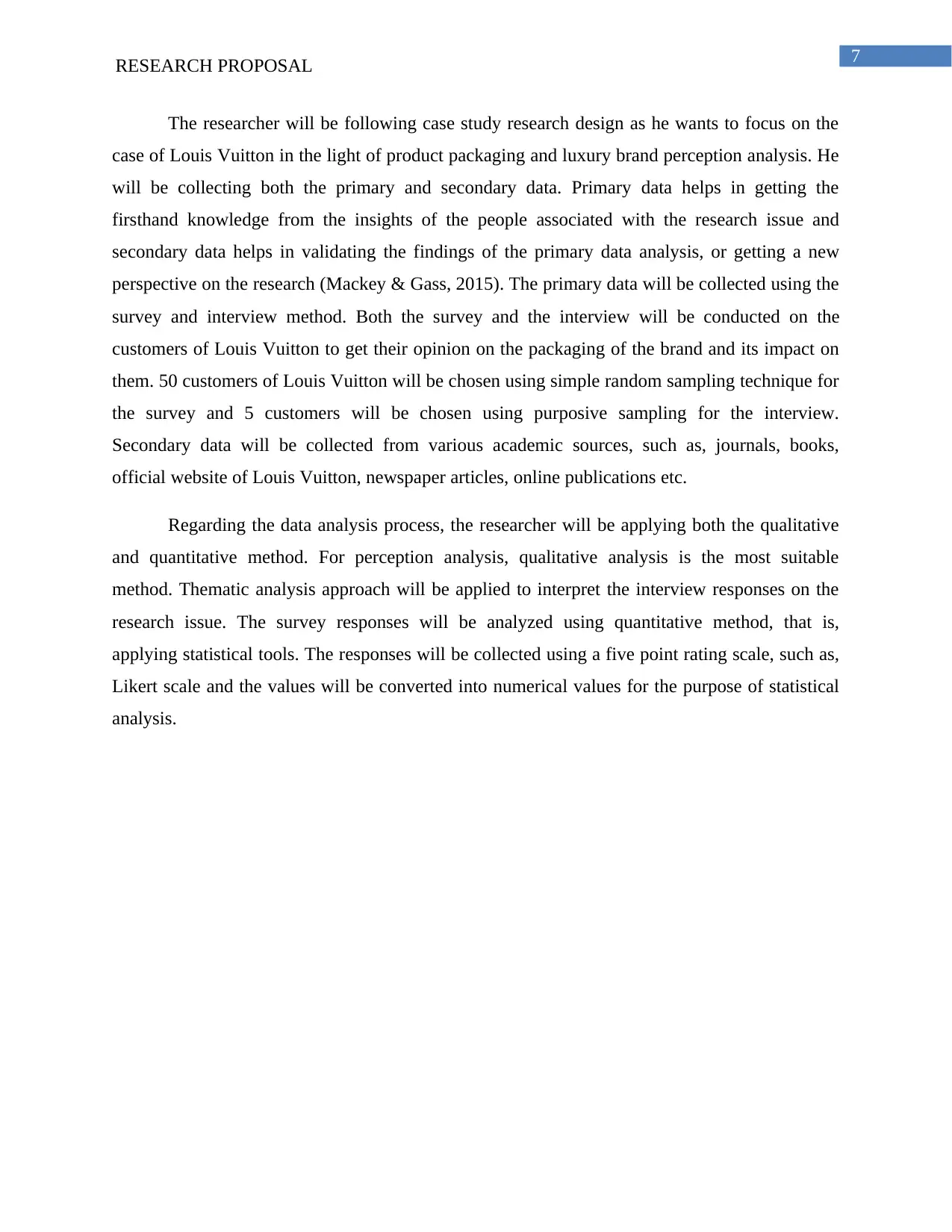
7RESEARCH PROPOSAL
The researcher will be following case study research design as he wants to focus on the
case of Louis Vuitton in the light of product packaging and luxury brand perception analysis. He
will be collecting both the primary and secondary data. Primary data helps in getting the
firsthand knowledge from the insights of the people associated with the research issue and
secondary data helps in validating the findings of the primary data analysis, or getting a new
perspective on the research (Mackey & Gass, 2015). The primary data will be collected using the
survey and interview method. Both the survey and the interview will be conducted on the
customers of Louis Vuitton to get their opinion on the packaging of the brand and its impact on
them. 50 customers of Louis Vuitton will be chosen using simple random sampling technique for
the survey and 5 customers will be chosen using purposive sampling for the interview.
Secondary data will be collected from various academic sources, such as, journals, books,
official website of Louis Vuitton, newspaper articles, online publications etc.
Regarding the data analysis process, the researcher will be applying both the qualitative
and quantitative method. For perception analysis, qualitative analysis is the most suitable
method. Thematic analysis approach will be applied to interpret the interview responses on the
research issue. The survey responses will be analyzed using quantitative method, that is,
applying statistical tools. The responses will be collected using a five point rating scale, such as,
Likert scale and the values will be converted into numerical values for the purpose of statistical
analysis.
The researcher will be following case study research design as he wants to focus on the
case of Louis Vuitton in the light of product packaging and luxury brand perception analysis. He
will be collecting both the primary and secondary data. Primary data helps in getting the
firsthand knowledge from the insights of the people associated with the research issue and
secondary data helps in validating the findings of the primary data analysis, or getting a new
perspective on the research (Mackey & Gass, 2015). The primary data will be collected using the
survey and interview method. Both the survey and the interview will be conducted on the
customers of Louis Vuitton to get their opinion on the packaging of the brand and its impact on
them. 50 customers of Louis Vuitton will be chosen using simple random sampling technique for
the survey and 5 customers will be chosen using purposive sampling for the interview.
Secondary data will be collected from various academic sources, such as, journals, books,
official website of Louis Vuitton, newspaper articles, online publications etc.
Regarding the data analysis process, the researcher will be applying both the qualitative
and quantitative method. For perception analysis, qualitative analysis is the most suitable
method. Thematic analysis approach will be applied to interpret the interview responses on the
research issue. The survey responses will be analyzed using quantitative method, that is,
applying statistical tools. The responses will be collected using a five point rating scale, such as,
Likert scale and the values will be converted into numerical values for the purpose of statistical
analysis.
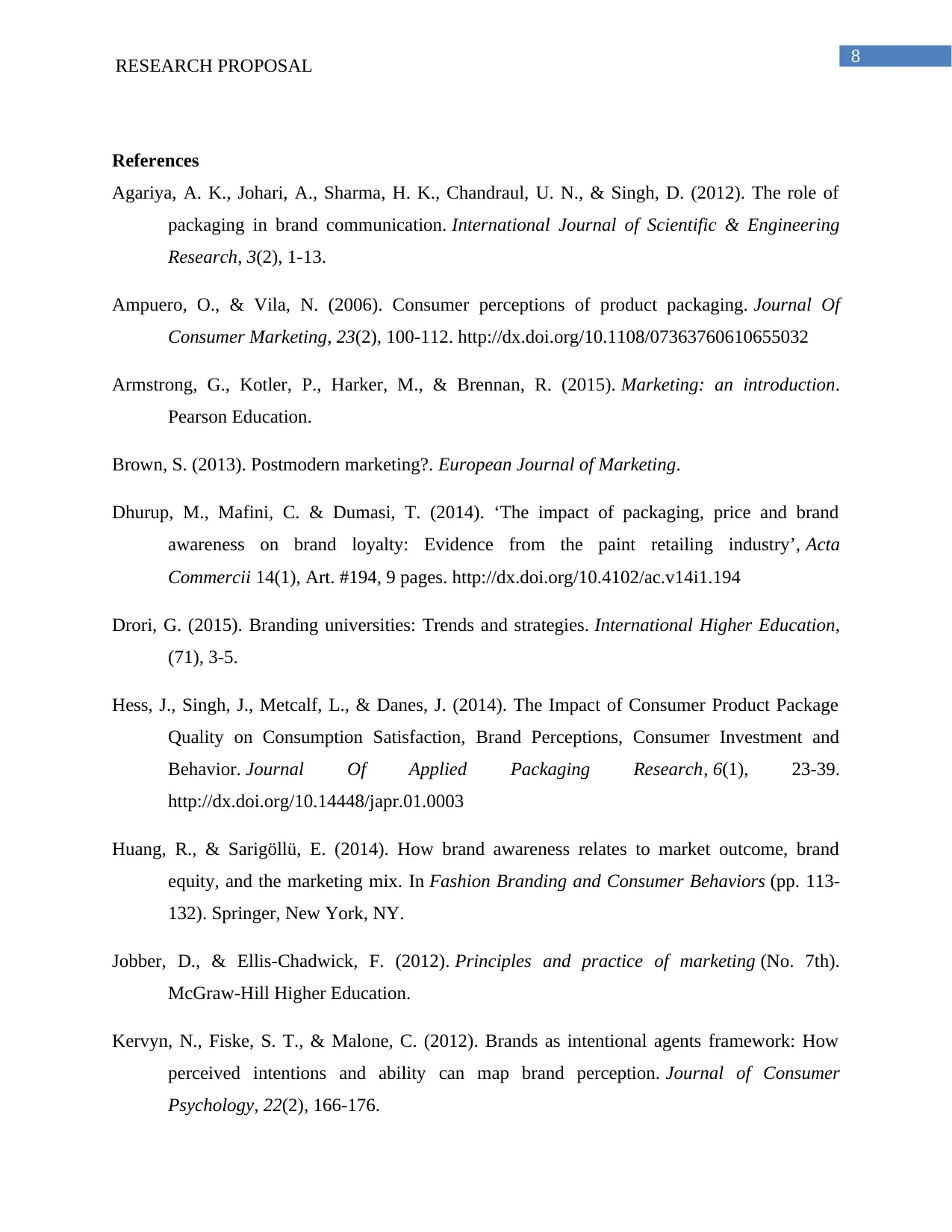
8RESEARCH PROPOSAL
References
Agariya, A. K., Johari, A., Sharma, H. K., Chandraul, U. N., & Singh, D. (2012). The role of
packaging in brand communication. International Journal of Scientific & Engineering
Research, 3(2), 1-13.
Ampuero, O., & Vila, N. (2006). Consumer perceptions of product packaging. Journal Of
Consumer Marketing, 23(2), 100-112. http://dx.doi.org/10.1108/07363760610655032
Armstrong, G., Kotler, P., Harker, M., & Brennan, R. (2015). Marketing: an introduction.
Pearson Education.
Brown, S. (2013). Postmodern marketing?. European Journal of Marketing.
Dhurup, M., Mafini, C. & Dumasi, T. (2014). ‘The impact of packaging, price and brand
awareness on brand loyalty: Evidence from the paint retailing industry’, Acta
Commercii 14(1), Art. #194, 9 pages. http://dx.doi.org/10.4102/ac.v14i1.194
Drori, G. (2015). Branding universities: Trends and strategies. International Higher Education,
(71), 3-5.
Hess, J., Singh, J., Metcalf, L., & Danes, J. (2014). The Impact of Consumer Product Package
Quality on Consumption Satisfaction, Brand Perceptions, Consumer Investment and
Behavior. Journal Of Applied Packaging Research, 6(1), 23-39.
http://dx.doi.org/10.14448/japr.01.0003
Huang, R., & Sarigöllü, E. (2014). How brand awareness relates to market outcome, brand
equity, and the marketing mix. In Fashion Branding and Consumer Behaviors (pp. 113-
132). Springer, New York, NY.
Jobber, D., & Ellis-Chadwick, F. (2012). Principles and practice of marketing (No. 7th).
McGraw-Hill Higher Education.
Kervyn, N., Fiske, S. T., & Malone, C. (2012). Brands as intentional agents framework: How
perceived intentions and ability can map brand perception. Journal of Consumer
Psychology, 22(2), 166-176.
References
Agariya, A. K., Johari, A., Sharma, H. K., Chandraul, U. N., & Singh, D. (2012). The role of
packaging in brand communication. International Journal of Scientific & Engineering
Research, 3(2), 1-13.
Ampuero, O., & Vila, N. (2006). Consumer perceptions of product packaging. Journal Of
Consumer Marketing, 23(2), 100-112. http://dx.doi.org/10.1108/07363760610655032
Armstrong, G., Kotler, P., Harker, M., & Brennan, R. (2015). Marketing: an introduction.
Pearson Education.
Brown, S. (2013). Postmodern marketing?. European Journal of Marketing.
Dhurup, M., Mafini, C. & Dumasi, T. (2014). ‘The impact of packaging, price and brand
awareness on brand loyalty: Evidence from the paint retailing industry’, Acta
Commercii 14(1), Art. #194, 9 pages. http://dx.doi.org/10.4102/ac.v14i1.194
Drori, G. (2015). Branding universities: Trends and strategies. International Higher Education,
(71), 3-5.
Hess, J., Singh, J., Metcalf, L., & Danes, J. (2014). The Impact of Consumer Product Package
Quality on Consumption Satisfaction, Brand Perceptions, Consumer Investment and
Behavior. Journal Of Applied Packaging Research, 6(1), 23-39.
http://dx.doi.org/10.14448/japr.01.0003
Huang, R., & Sarigöllü, E. (2014). How brand awareness relates to market outcome, brand
equity, and the marketing mix. In Fashion Branding and Consumer Behaviors (pp. 113-
132). Springer, New York, NY.
Jobber, D., & Ellis-Chadwick, F. (2012). Principles and practice of marketing (No. 7th).
McGraw-Hill Higher Education.
Kervyn, N., Fiske, S. T., & Malone, C. (2012). Brands as intentional agents framework: How
perceived intentions and ability can map brand perception. Journal of Consumer
Psychology, 22(2), 166-176.
⊘ This is a preview!⊘
Do you want full access?
Subscribe today to unlock all pages.

Trusted by 1+ million students worldwide
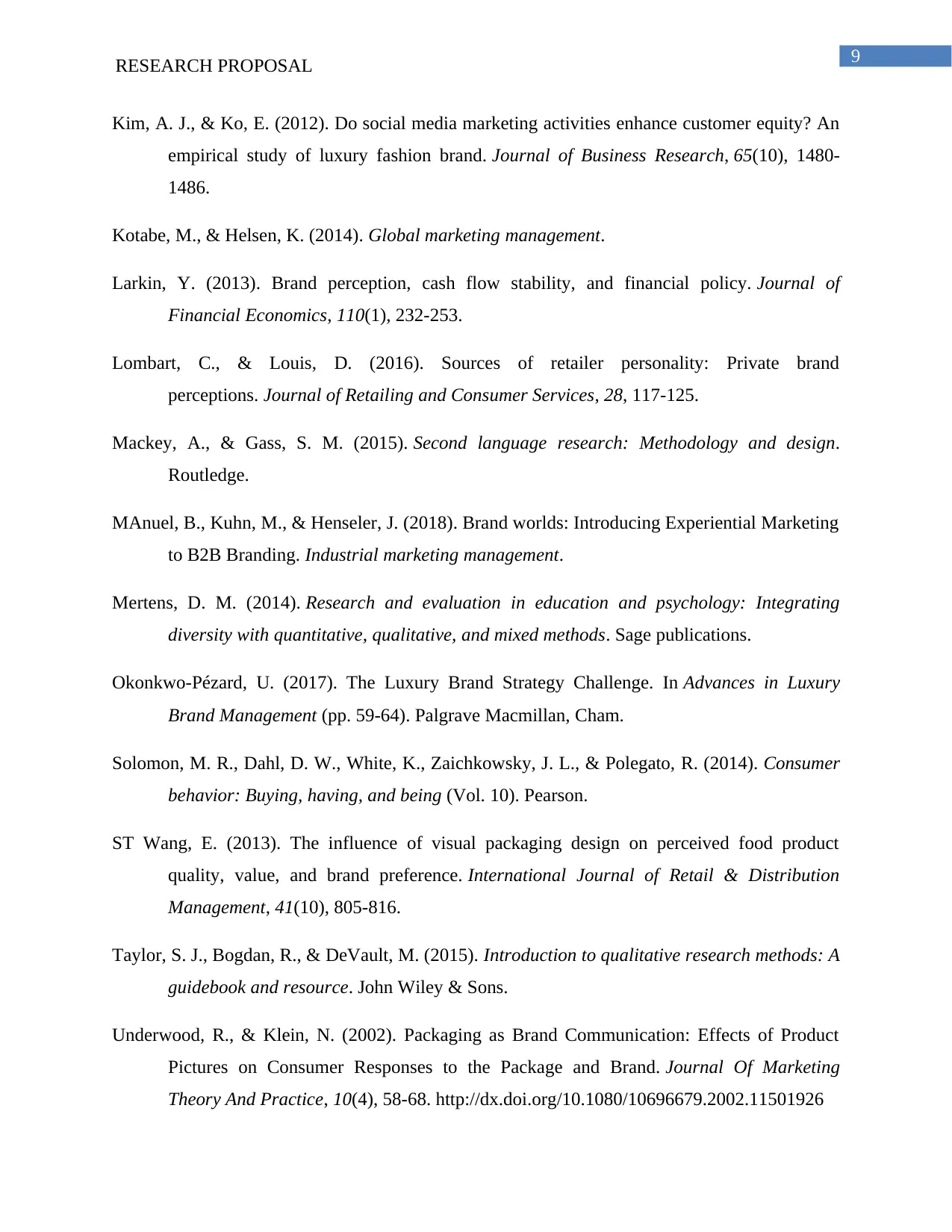
9RESEARCH PROPOSAL
Kim, A. J., & Ko, E. (2012). Do social media marketing activities enhance customer equity? An
empirical study of luxury fashion brand. Journal of Business Research, 65(10), 1480-
1486.
Kotabe, M., & Helsen, K. (2014). Global marketing management.
Larkin, Y. (2013). Brand perception, cash flow stability, and financial policy. Journal of
Financial Economics, 110(1), 232-253.
Lombart, C., & Louis, D. (2016). Sources of retailer personality: Private brand
perceptions. Journal of Retailing and Consumer Services, 28, 117-125.
Mackey, A., & Gass, S. M. (2015). Second language research: Methodology and design.
Routledge.
MAnuel, B., Kuhn, M., & Henseler, J. (2018). Brand worlds: Introducing Experiential Marketing
to B2B Branding. Industrial marketing management.
Mertens, D. M. (2014). Research and evaluation in education and psychology: Integrating
diversity with quantitative, qualitative, and mixed methods. Sage publications.
Okonkwo-Pézard, U. (2017). The Luxury Brand Strategy Challenge. In Advances in Luxury
Brand Management (pp. 59-64). Palgrave Macmillan, Cham.
Solomon, M. R., Dahl, D. W., White, K., Zaichkowsky, J. L., & Polegato, R. (2014). Consumer
behavior: Buying, having, and being (Vol. 10). Pearson.
ST Wang, E. (2013). The influence of visual packaging design on perceived food product
quality, value, and brand preference. International Journal of Retail & Distribution
Management, 41(10), 805-816.
Taylor, S. J., Bogdan, R., & DeVault, M. (2015). Introduction to qualitative research methods: A
guidebook and resource. John Wiley & Sons.
Underwood, R., & Klein, N. (2002). Packaging as Brand Communication: Effects of Product
Pictures on Consumer Responses to the Package and Brand. Journal Of Marketing
Theory And Practice, 10(4), 58-68. http://dx.doi.org/10.1080/10696679.2002.11501926
Kim, A. J., & Ko, E. (2012). Do social media marketing activities enhance customer equity? An
empirical study of luxury fashion brand. Journal of Business Research, 65(10), 1480-
1486.
Kotabe, M., & Helsen, K. (2014). Global marketing management.
Larkin, Y. (2013). Brand perception, cash flow stability, and financial policy. Journal of
Financial Economics, 110(1), 232-253.
Lombart, C., & Louis, D. (2016). Sources of retailer personality: Private brand
perceptions. Journal of Retailing and Consumer Services, 28, 117-125.
Mackey, A., & Gass, S. M. (2015). Second language research: Methodology and design.
Routledge.
MAnuel, B., Kuhn, M., & Henseler, J. (2018). Brand worlds: Introducing Experiential Marketing
to B2B Branding. Industrial marketing management.
Mertens, D. M. (2014). Research and evaluation in education and psychology: Integrating
diversity with quantitative, qualitative, and mixed methods. Sage publications.
Okonkwo-Pézard, U. (2017). The Luxury Brand Strategy Challenge. In Advances in Luxury
Brand Management (pp. 59-64). Palgrave Macmillan, Cham.
Solomon, M. R., Dahl, D. W., White, K., Zaichkowsky, J. L., & Polegato, R. (2014). Consumer
behavior: Buying, having, and being (Vol. 10). Pearson.
ST Wang, E. (2013). The influence of visual packaging design on perceived food product
quality, value, and brand preference. International Journal of Retail & Distribution
Management, 41(10), 805-816.
Taylor, S. J., Bogdan, R., & DeVault, M. (2015). Introduction to qualitative research methods: A
guidebook and resource. John Wiley & Sons.
Underwood, R., & Klein, N. (2002). Packaging as Brand Communication: Effects of Product
Pictures on Consumer Responses to the Package and Brand. Journal Of Marketing
Theory And Practice, 10(4), 58-68. http://dx.doi.org/10.1080/10696679.2002.11501926
Paraphrase This Document
Need a fresh take? Get an instant paraphrase of this document with our AI Paraphraser

10RESEARCH PROPOSAL
Wheeler, A. (2017). Designing brand identity: An essential guide for the whole branding team.
John Wiley & Sons.
Wheeler, A. (2017). Designing brand identity: An essential guide for the whole branding team.
John Wiley & Sons.
1 out of 11
Related Documents
Your All-in-One AI-Powered Toolkit for Academic Success.
+13062052269
info@desklib.com
Available 24*7 on WhatsApp / Email
![[object Object]](/_next/static/media/star-bottom.7253800d.svg)
Unlock your academic potential
Copyright © 2020–2025 A2Z Services. All Rights Reserved. Developed and managed by ZUCOL.





